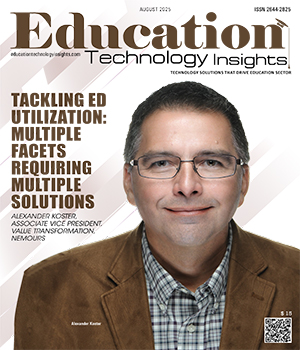THANK YOU FOR SUBSCRIBING
Be first to read the latest tech news, Industry Leader's Insights, and CIO interviews of medium and large enterprises exclusively from Education Technology Insights
Balancing Technology and People in a Dynamic School System
Brendan Browne, Director of Education and Mike Damad, Chief Information Officer
 Brendan Browne, Director of Education and Mike Damad, Chief Information Officer
Brendan Browne, Director of Education and Mike Damad, Chief Information OfficerBrendan Browne, Director of Education, and Mike Damad, Chief Information Officer at the Toronto Catholic District School Board, combine strategic educational leadership with technological expertise. Browne drives student-focused learning and system-wide initiatives, while Damad ensures innovative, secure, and efficient technology solutions, together fostering a culture of collaboration, adaptability, and impactful education.
In an exclusive interview with Education Technology Insights, Browne and Damad share their insights on driving student-focused learning, implementing innovative technology solutions, and fostering a culture of collaboration and adaptability.
Keeping Learning Human in a Digital Age
At the Toronto Catholic District School Board, we run the world’s largest publicly funded Catholic board with nearly 200 schools serving 90,000 students. There is structure to the week: Mondays begin with the senior team meeting, followed by the Director’s Council on Tuesdays to align strategy, monitor initiatives, and address emerging issues.
As the week unfolds, priorities evolve. Major technology projects advance, for instance, a new staffing management platform and a special education system, while provincial or school matters may also demand our attention. Flexibility here is essential, which is why the calendar is a guideline, rather than a fixed plan. Throughout this work, technology is a core focus, but people remain at the center, ensuring the right individuals are in the right roles and that challenges are met with care and agility.
AI, Cybersecurity, and Humans
At the Toronto Catholic District School Board, daily operational challenges are treated as opportunities to improve teaching and learning. Two priorities define this work: expanding students’ access to modern technologies, especially responsible AI, and strengthening cybersecurity so instruction continues without fear of digital compromise. Large‑scale systems integration is another major area of focus.
A significant transformational project with implementing the new Student Information System has allowed the board to interconnect attendance, special education and HR systems ensuring a seamless dataflow.
Equally critical is the human side of change. Moving to new platforms requires training, patience, and cultural adaptation. Initiatives like staffing modelling solution and the special education platform overhaul demand precise technical coordination and deliberate change management that builds confidence and mastery.
From Isolation to Integration
A major breakthrough is the dismantling of silos. Where attendance, special education, and Individualized Education Plans (IEP) management once operated independently, integrated systems now enable secure, efficient information flow. This has transformed operations, delivered significant efficiency gains, and freed more time for student success.
“Change is uncomfortable but necessary. Growth depends on adapting to it with curiosity and flexibility, while keeping people front and center.”
The board is embracing an enterprise mindset, treating technology as one interconnected ecosystem, a technical and cultural shift sustained by change management that highlights downstream impacts and the value of cross‑department collaboration. AI is central to this evolution, from lesson‑planning tools that lighten administrative load to chatbots supporting corporate service desks, with pilots underway and more in development. The aim is to enhance enterprise applications, streamline operations, and better support educators and students.
Equally important is the culture enabling it. The Director’s Council is a collection of our organization’s most senior leaders, spanning education, operations, technology, finance, communications, HR, legal, curriculum, and field services. Our team grounds decisions in multidisciplinary expertise and reinforces a culture of shared ownership. This collaborative model fosters continuous learning, where leaders work across domains as one system pursuing shared goals.
Technology that Supports Growth
The future of education is people‑centered. Even as technology advances, the mission remains developing independent thinkers, skilled problem solvers, and empathetic collaborators. The humanities, arts, and philosophy stay vital because they cultivate critical thinking, creativity, adaptability, and emotional intelligence, capacities machines cannot replace.
Students must learn to work with technology. Not be replaced by it, but use AI tools, to accelerate learning and to focus on more complex challenges. AI will also strengthen early, precise support by analyzing patterns to surface needs sooner and enable targeted interventions tailored to each learner. Technology’s role is to reduce administrative burdens, address language and accessibility challenges, and create more equitable opportunities to learn. It is not about replacing teachers or students but empowering them to achieve better outcomes.
Curiosity First, Flexibility Always
Curiosity is foundational to leadership today: keep asking questions and embrace evolution over mastery in a landscape where tools outpace systems. Leaders and educators should be comfortable with uncertainty and willing to explore new ideas. Cultivate critical thinking across staff and students; treat technology as an enabler of analysis and reflection. For example, invite students to use AI for an assignment, and then critique the output for gaps to build discernment and adaptability.
Change is also systemic: executives must engage stakeholders early, seek input, and make staff co‑creators of the initiatives shaping their work. Change is uncomfortable but necessary, and growth depends on adapting with curiosity and flexibility; all while keeping people at the center.
In education, adapting to change isn’t just strategy, it’s practice. It embodies the lifelong learning we seek to inspire in our students and ourselves.
Read Also
Navigating the Grey: A New Framework for AI in Higher Education
Irreplaceable: Schools that Prepare Future-Ready Learners
Inspiring Futures Through Access and Opportunity
Reframing Social and Emotional Learning: From Reservations to Renewal
Innovative Leadership in Professional Learning Programs
Balancing Technology and People in a Dynamic School System

I agree We use cookies on this website to enhance your user experience. By clicking any link on this page you are giving your consent for us to set cookies. More info

However, if you would like to share the information in this article, you may use the link below:
www.educationtechnologyinsightseurope.com/cxoinsights/brendan-browne-nid-3519.html






















